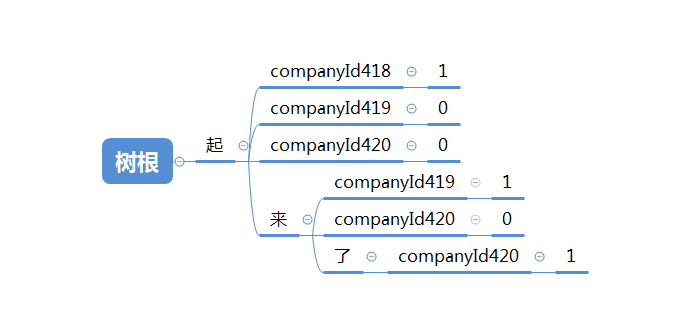溫馨提示×
您好,登錄后才能下訂單哦!
點擊 登錄注冊 即表示同意《億速云用戶服務條款》
您好,登錄后才能下訂單哦!
這期內容當中小編將會給大家帶來有關如何在Java項目中利用DFA算法實現一個過濾敏感字功能,文章內容豐富且以專業的角度為大家分析和敘述,閱讀完這篇文章希望大家可以有所收獲。
模式圖

直接上代碼
public class KeywordFilter {
// private static ReentrantReadWriteLock lock = new ReentrantReadWriteLock();
public static Map<String, HashMap> currentMap = new ConcurrentHashMap<String, HashMap>();
public static Map nowhash = null;
public static Object wordMap;// map子節點
// 不建立對象
private KeywordFilter() {
}
private static String getKey(int companyId) {
return "companyId" + companyId;
}
/*
* <p>說明:清掃內容</p>
*
*
* @data:2017-8-22 上午10:13:11
*/
public static void clear() {
try {
currentMap.clear();
} catch (Exception e) {
e.printStackTrace();
} finally {
}
}
/*
* <p>說明:各個渠道的過濾字符</p>
*
*
* @data:2017-8-20 下午2:55:06
*/
public static void saveKeywords(int companyId, List<String> keywords) {
try {
Map tempAllMap = currentMap;
String key = getKey(companyId);
int l = keywords.size();
int il;
Map tempMap;
for (int i = 0; i < l; i++) {
String key2 = keywords.get(i).trim();// 去掉空白
nowhash = currentMap;
il = key2.length();
for (int j = 0; j < il; j++) {
char word = key2.charAt(j);
tempMap = (Map) nowhash.get(word);
wordMap = nowhash.get(word);
if (wordMap != null) {// 檢查數據
if (!tempMap.containsKey(key)) {
nowhash.put(key, 0);
}
nowhash = (HashMap) wordMap;
} else {
HashMap<String, String> newWordHash = new HashMap<String, String>();
newWordHash.put(key, "0");
nowhash.put(word, newWordHash);
nowhash = newWordHash;
}
if (j == il - 1) {
nowhash.put(key, "1");
}
}
}
} catch (Exception e) {
e.printStackTrace();
} finally {
nowhash = null;
wordMap = null;
}
}
/*
* <p>說明:替換掉對應的渠道規定掉敏感字</p>
*
*
* @data:2017-8-20 上午11:41:47
*/
public static List<String> repword(int companyId, String txt) {
Map tempMap = currentMap;
List<String> result = new ArrayList<String>();
String key = getKey(companyId);
nowhash = currentMap;
int l = txt.length();
char word;
String keywordStr = "";
String keyStatu;
StringBuilder keyword = new StringBuilder();// 敏感字
for (int i = 0; i < l; i++) {
word = txt.charAt(i);
wordMap = nowhash.get(word);
if (wordMap != null) {// 找到類似敏感字的字體,開始查詢
keyword.append(word);
Object te = nowhash = (HashMap) wordMap;
// 遍歷到這一步,就符合完整的關鍵字模板
if (nowhash.get(key) != null
&& nowhash.get(key).toString().equals("1")) {// 確定是敏感字,開始替換
if (i < l - 1 && nowhash.get(txt.charAt(i + 1)) != null) {// 優先過濾長敏感詞,去掉就檳城了優先過濾段敏感詞
continue;
}
txt = txt.replaceAll(keyword.toString(), "*");
nowhash = currentMap;
keywordStr += keyword.toString() + ",";
i = i - keyword.length() + 1;
l = txt.length();// 重新獲取字符長度
keyword.delete(0, keyword.length());// 清空數據
}
} else {// 這個字不是敏感字,直接排除
nowhash = currentMap;
keyword.delete(0, keyword.length());// 清空數據
continue;
}
}
// 清除內存指向
nowhash = null;
wordMap = null;
result.add(txt);
result.add(keywordStr.length() - 1 > 0 ? keywordStr.substring(0,
keywordStr.length() - 1) : keywordStr);
return result;
}
/*
* <p>說明:檢查是否存在敏感字</p>
*
*
* @data:2017-8-20 下午3:00:06 專門設計成私有的,如果沒有理由,別改動他
*/
private static int checkKeyWords(String txt, int companyId, int begin) {
int result = 0;
String key = getKey(companyId);
try {
nowhash = currentMap;
int l = txt.length();
char word = 0;
for (int i = begin; i < l; i++) {
word = txt.charAt(i);
wordMap = nowhash.get(word);
if (wordMap != null) {
result++;
nowhash = (HashMap) wordMap;
if (((String) nowhash.get(key)).equals("1")) {
nowhash = null;
wordMap = null;
return result;
}
} else {
result = 0;
break;
}
}
} catch (Exception e) {
e.printStackTrace();
} finally {
nowhash = null;
wordMap = null;
return result;
}
}
/*
* <p>說明:返回檢查的文本中包含的敏感字</p>
*
*
* @data:2017-8-20 下午3:32:53
*/
public static String getTxtKeyWords(String txt, int companyId) {
String result = null;
StringBuilder temp = new StringBuilder();
String key;
int l = txt.length();
for (int i = 0; i < l;) {
int len = checkKeyWords(txt, companyId, i);
if (len > 0) {
key = (txt.substring(i, i + len));// 挑選出來的關鍵字
temp.append(key + ",");
txt = txt.replaceAll(key, "");// 挑選出來的關鍵字替換成空白,加快挑選速度
l = txt.length();
} else {
i++;
}
}
if (temp.length() > 0) {
result = temp.substring(0, temp.length() - 1);
}
return result;
}
/*
* <p>說明:判斷文中是否包含渠道規定的敏感字</p>
*
* @data:2017-8-20 下午3:33:19
*/
public boolean isKeyWords(String txt, int companyId) {
for (int i = 0; i < txt.length(); i++) {
int len = checkKeyWords(txt, companyId, i);
if (len > 0) {
return true;
}
}
return false;
}
public static void main(String[] arg) {
List<String> keywords = new ArrayList<String>();
keywords.add("傻×");
keywords.add("漢*");
keywords.add("草");
keywords.add("草泥馬");
KeywordFilter.saveKeywords(1, keywords);
String txt = "是傻×漢*傻A傻B傻C傻D漢*傻×草泥馬";
List<String> list = repword(1, txt);
System.out.println("文中包含的敏感字為:" + list.get(1));
System.out.println("原文:" + txt);
System.out.println("敏感字過濾后:" + list.get(0));
}
}上述就是小編為大家分享的如何在Java項目中利用DFA算法實現一個過濾敏感字功能了,如果剛好有類似的疑惑,不妨參照上述分析進行理解。如果想知道更多相關知識,歡迎關注億速云行業資訊頻道。
免責聲明:本站發布的內容(圖片、視頻和文字)以原創、轉載和分享為主,文章觀點不代表本網站立場,如果涉及侵權請聯系站長郵箱:is@yisu.com進行舉報,并提供相關證據,一經查實,將立刻刪除涉嫌侵權內容。